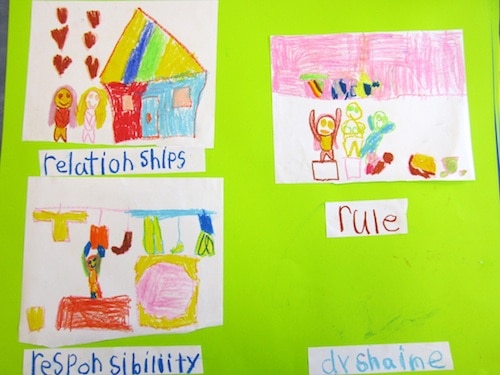Can Six Year Olds Really Demonstrate Their Learning?

By Kathy Cassidy
This week we finished up another one of our project based learning (PBL) or inquiry-based units in my first grade classroom. It had the grand title of rules, relationships and responsibilities.
Why I Let Students Take the Lead in Learning Demonstration
At the end of each of our units, I have the students create an artifact that can be posted on their blog to show what each of them has learned about our topic of study. I have never been a big supporter of “tests”, especially in first grade, where the students are usually much more comfortable showing learning in a verbal way rather than a written one. As an alternative, I ask the students to create something—a video, a podcast, a drawing—whatever works for that child to best show his learning.
Even as young as six years old, students begin to realize that they are stronger in some areas than others. If I truly want to know what a student knows about a social studies topic, asking for a written paragraph from all of them does not make sense. Only those who are strong writers will do well. The others don’t really have a chance to effectively show me what they know.
Some students do like to write. For them, writing is a successful way to show what they know. Some students can most effectively show their learning in a drawing. For others, a podcast or video is a better choice.
For these reasons, I always let the students chose the way they present their learning. When I first began using PBL in my classroom, I was concerned that the students might only choose their favorite technology for each project we did, without giving thought to how they could truly show their learning in a meaningful way. That has not proved to be the case.
Setting Clear Expectations & Guidelines Promotes Success
Before we began working, we talked about the options that might work well for archiving learning in this unit. Some of the ideas we came up with together included drawing and labeling pictures (digital or with markers, crayons or pastels), writing, making posters, making screencasts, using the Livescribe pen, making videos or making podcasts. I was open to any suggestions that would give the students a chance to clearly articulate what they knew.
We also discussed what needed to be included to make a good project. My school uses four levels of achievement for young students: Limited, Adequate, Meeting and Excellent. We looked at a rubric together so that the students would know exactly what they needed to do to attain each of those levels of achievement. In the past, I have had the students make the rubric with me, but this time I made it ahead of time and asked for their input instead.
Students Exceeded Expectations & Demonstration of Learning
With the expectations clear in their minds, the students set off to make their projects. The choices that the students made to show their learning surprised me. Three students chose to draw digital pictures. These three students also used Audioboo to make a podcast that explained their pictures and learning. None of the students chose to make a screencast on an iPad or to use the Livescribe Pen. None of the students were interested in writing what they knew. (Since they are just emerging writers, this was probably a good choice for them.)
The rest of the students all chose to make a poster. Perhaps it is hard to resist the lure of the beautiful colours of tagboard we have in the classroom. Many of them had chosen to make a poster at the end of another PBL unit we had done, so perhaps it was familiarity that made this an overwhelming choice. Drawing is a comfortable and age appropriate way for six year olds to explain their learning. It is much more difficult to put details into a digital drawing than it is to a drawing on paper using markers or pastels, so again the students made a choice that worked well for them.
Showcasing Student Works Brings Ownership, Pride and Expression to Classroom Learning
Once the students’ posters were complete, we wanted to be able to showcase what the students had done on their blogs, so we made videos of the students explaining what they had chosen to include in their poster. As we recorded their podcasts or videos, the students explained their thinking, and I often asked questions to try to pull out all of the things they knew.
The videos, podcasts and pictures were all uploaded and embedded on the students’ blogs, becoming one more part of each student’s digital portfolio. Their artifact is now visible to their parents, friends and grandparents who might live in a distant city.
The students take great pride in their blogs. They love to show it to anyone who will take the time to look at it with them. The writing and artifacts it contains were created by THEM and show what THEY have learned. A favorite activity is to look at their writing at the beginning of the year and grin as they see the progress they have made. When we are working on something in our classroom, it is common for them to ask “Can we put this on our blogs?” They want to show the world what they can do.
Given the chance, six-year olds can be articulate in explaining their own learning and make appropriate choices to demonstrate what they know. The choices just need to be suitable to their level. For six-year olds, that is often through drawings and oral explanations. Clearly my previous concerns about the students not making good choices were misplaced.


jorataga
excellent work.